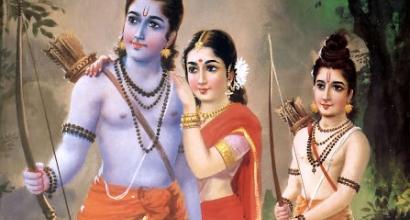It is interesting to note that the Indian writers on the Kāma-śāstra classified the heroines as Padminī, Cittinī, Hastinī and Śaṅkinī, primarily based on their physical and sociological attributes. They were also categorised into svīyā, parakīyā and sādhāraṇā based on the same parameters. On the other hand, aestheticians who are well versed with the Nāṭya tradition of India classify the heroines based on their emotional states, which is subtler and more meaningful than the former. An actor, who is going to put on the role of a śṛṅgāra-nāyikā should keep these categories in mind. For example, Sītā is a Uttamā (superior kind), Divyādivyā (semi-human and semi-divine) and a tṛpta-svīyā nāyikā(a contended, devout wife). She is a noble lady, full of humility and courteous by nature. (In most circumstances, she is at least a dhīrā and madhyā – bold and good in her characteristics). To consider another example, Satyabhāmā is adviyā (non-divine), madhyā (good, middling) and a svīyā (devout) to her husband. Vasantasenā is a Sādārana-nāyikā. Radhā is a parakīyā, adviyā, uttamā and paroḍhā. [The defining characteristics of these heroines have been described in the previous part].
As discussed in the previous part of the article, nāyikā are of 4,185 kinds in total. Taking only their citta-vṛttis (emotional landscape) into consideration, they are divided into eight categories. When the sub-types are included, they add up to twelve.
The popular eight, based on the emotional landscape of the heroines are: svādhīnapathikā, vāsakasajjikā, virahotkaṇṭhitā, vipralabdhā, khaṇḍitā, kalahāntaritā, proṣitabhartṛkā and abhisārikā. These are the aṣṭanāyikās. As a function of the mental states of the heroine who is sending away her beloved and receiving her beloved, proṣitabhartṛkā is sub-divided into two kinds respectively - pravatsyatpatikā and samāgacchatpatikā. As a function of the time of the day and the climatic conditions under which an abhisārikā sets out, she is of four kinds, namely - jyotsnābhisārikā, tamisrābhisārikā, divasābhisārikā and varṣābhisārikā. With these additional varieties, the total possible kinds are 50,220!
Even with these myriad possibilities, the aṣṭanāyikās, i.e., svādhīnapathikā and others form the primary type. This is because, this classification, as previously mentioned is purely based on the emotions and different stages in the life of a nāyikā. It involves the love and affection between a lady and her man and is universal in its spirit. Moreover, all the other 4,185 kinds undergo these eight states. These characters need to be depicted keeping in mind their personalities, socio-cultural backgrounds, age and mental states. There is tremendous difference between an abhisārikā who is a mugdhā, jñānta-yauvanā and uttamā on one hand and an abhisārikā who is a paroḍhā, kulaṭā and adhama-parakīya-nāyikā. The manner in which they set out on an abhisārikā (search for beloved) is very different. Taking a specific example, the manner in which Rādhā behaves as a Khaṇḍitā- nāyikā is different from how Satyabhāmā would behave.
Let us take an overview of the aṣṭanāyikās
Svādhīnapathikā is someone who has her husband entirely under her control. He is a mere puppet and dances to her tunes. The husband is obedient and is subordinated by his lady. A svādhīnapathikā displays joyous bashfulness, confidence, pride and is very bold.
Vāsakasajjikā is a lady who expectantly waits for the homecoming of her beloved well before the sunset. She cleans up the house, decorates the indoors and waits at the door. The confidence she has at the beginning gradually decreases as the evening passes by and the night falls. She is eagerly looking forward in the late afternoon and early evening. Her eagerness will slowly take the shades of anxiety, suspect and sorrow. She has disappointment mixed with traces of joy, as her thoughts change.
Abhisārikā is a lady who has a predetermined meeting spot with her beloved and heads out in his search. She decks up herself and beautifies her appearance for the pleasure of her beloved. Depending on the time of the day and the season in which she heads out, she can be of different kinds – A divasābhisārikā sets out in broad daylight, tamisrābhisārikā sets out in the night of Kṛṣṇa-pakṣa (dark half of the moon) or on a no moon night. (It is common for a divasābhisārikā and tamisrābhisārikā to be parakīya-nāyikās. It is easy to step out of the house during the day under some pretext to meet her extra-marital lover. There is no one to question or to stop a lady who stealthily escapes at night, anyway!) Jyotsnābhisārikā sets out during a full moon night and Varṣābhisārikā does not even care for the rains when she seeks the company of her beloved. These ladies have good taste for life and are confident. They are usually maidens or prostitutes. (Ūrvaśī as seen in the third act of Vikramorvaśīyam and Vasantasenā of the fifth act of Mṛcchakaṭikam respectively are Jyotsnābhisārikā and Varṣābhisārikā. It is also noteworthy that both are Sādhāraṇa-nāyikās). The nāyikās who set out as abhisārikās may display traces of fear or bravery in the process, as a function of their innate nature. They have confidence which emanates from her eagerness for pleasure and her intense love for the beloved.
A abhisārikā who does not see her lover at the predetermined meeting spot (saṅketa-sthala) gets disappointed. Several thoughts and suspicions occur to her mind. Still, she is sure of his commitment to her. Her fear for the world and people’s comments get bottled up. Sorrow and restlessness take shape in her mind. A nāyikā in this state is Vipralabdhā.
When her separation from her beloved is prolonged, her sorrow knows no bounds. The moon (candra), cool breeze (malayānila), flowers (kusuma) and the cupid (manmatha) turn out to be her enemies, as she gets averse to these elements, which would have otherwise given her pleasure under normal circumstances. Sandalwood paste (Candana) and camphor (karpūra) soothe her mind and body. She is now a Virahotkhaṇṭitā with these features. She gradually grows suspicious about the devotion of her beloved. She starts censuring nature and the imagined ‘other’ lady of her beloved. (These are called Upālambha). The cupid (Manmatha) too starts playing pranks on her, figuratively. She sends out a sakhi (friend) or a dūti (messenger) to trace her beloved and also has a message for him. (A pervert dūti, at times, can take this opportunity to have an affair with her mistress’ beloved too! The affair might become obvious to the heroine, when she notices love marks on her dūti’s body. The heroine may then corner her with sarcastic remarks or make a direct verbal attack.) A lady who is distressed in this manner is a Virahotkhaṇṭitā.
It is likely that the hero already had rendezvous with her other wives or lovers. As soon as the heroine sees him, she suspects that he has just had a meeting with the others and has delayed his arrival. (She might even accuse a lover of pure character to have lost himself to someone else). She decides that such a man is not worthy of her love and out rightly rejects him. These characterise a Khaṇḍitā nāyikā. Depending on her social status, innate nature and experience, she might either be soft or harsh in the manner in which she gets away from her beloved.
The rejected man is now sad and is unable to stay there any longer. He is humiliated and might leave the place out of dejection or anger. This lets the heroine contemplate and she repents her actions (The sakhi might also help the heroine reconsider her decision and change her mind). The heroine is now pained to see her hero gone away and rebukes herself for being so unsympathetic. The heroine in this state is called a Kalahāntaritā.
Finally, the hero comes back to the heroine of his own accord, or it might get initiated by a dūti. As per the popular saying, the fight between a man and his lady lasts as long as they are away from bed. As soon as they retire for the day, all differences vanish and intense love blossoms. In this state, the heroine is a Svādhīnapathikā.
A vāsakasajjikā gets ready in the evening, around the time of sunset. If an abhisārikā sets out when the moon raises up, the early hours of the night will make the lady a vipralabdhā. In the later hours of the half of the night, she is a Virahotkaṇṭitā and will gradually turn into a Khaṇḍitā and kalahāntaritā is the latter half of the night. It is only in the wee hours that the reunion with her beloved happens. When her happiness endures throughout the following day, she is a svādhīnapatikā. The misery of the heroine is tremendous when her hero sets out on a voyage. She has mixed emotions, ranging from sorrow and pain to anxiety and suspicion. She can be classified as a proṣitabhartṛkā. Sometimes, after the reunion with his heroine in the wee hours, the hero might bid her farewell again and head out on a short journey. She will remain a proṣitabhartṛkā until he returns. With this perspective, it can be said that a lady undergoes all the eight states of the nāyikās on a single day.
In sum, all the different possibilities, shades and flavours of the emotional landscape of a lady in love can be seen in these categories of heroines. Though, a first glance at this classification might give the impression that the categories are superfluous, with a more patient reading, it will be revealed that these are true for all women (and men) of all. This, truly, is the merit of the Indian arts and aesthetics. Our aestheticians have described universal truths that can come to the direct experience of every individual.
Bhānudatta, in his Rasamañjarī, asks if it is also possible to classify Nāyaka into eight categories in a similar fashion (अवस्थाभेदेन यदि भेदो नायकस्य स्यात्तदोत्कविप्रलब्धखण्डितादययो नायकाः स्वीकर्तव्याः). His doubt arises because, he wonders if it will disrupt the rasa if polyandry and male prostitutes are present in the society. (It was a time when polygamy was socially accepted and its portrayal in art wasn’t considered out of place). The doubt that Bhānudatta expresses is quite unfounded. This is because, with categorising women as svīyā, parakīyā and sādhāraṇā, their counterparts are put into complementary categories such as pati, upapati and vaiśika, respectively. Thus, in the same way, one can come up with an aṣṭanāyaka classification as counterparts for these aṣṭanāyikās. They complement the emotional states of the heroines and the current author has defined the categories of heroes and has been successful in getting them portrayed through different forms of art. The categories are:
Kāntāvidheya – husband who is obedient, counter part of a Svādhīnapatikā
Bhāminībhīta – a nāyaka who desires to meet a Vāsakasajjikā but is scared that she might be angry with him.
Abhisāraka – a nāyaka who heads towards saṅketasthaḻa (a premeditated meeting spot); the counterpart of a Abhisārakā
Nirīkṣaka – A nāyaka who waits for his beloved at the premeditated place; the counterpart of a vipralabdhaa
Virahi – a nāyaka who suffers tangs of separation from his beloved.
Kalahāntarita – After a fight with his heroine, this nāyaka repents for his act.
Narmaprasādaka – He patches up with his lady after a fight. He cajoles even a khaṇḍitā nāyikā with his sweet words.
Pāntha – A travelling nāyaka. His lady is a proṣitabhartṛkā.
The current author has given Sanskrit definitions characteristics for the characteristics of these heroes and has also composed songs set to specific raga and tāḻas. Additionally, he has composed hundreds of songs and padams in Kannada, Sanskrit and Telugu languages. Many of these have been successfully presented in concerts around the world.
The description of the romantic lives of such heroes and heroines is endless. Bharatamuni has aptly said that Nāṭya is the exalted imitation of the emotions of the three worlds. Universalization and idealisation of emotions and their careful delineation through different forms of arts evokes Rasānanda. This is the Rasa-mystery and Aucitya is the Upaniṣad of Rasānanda!











































